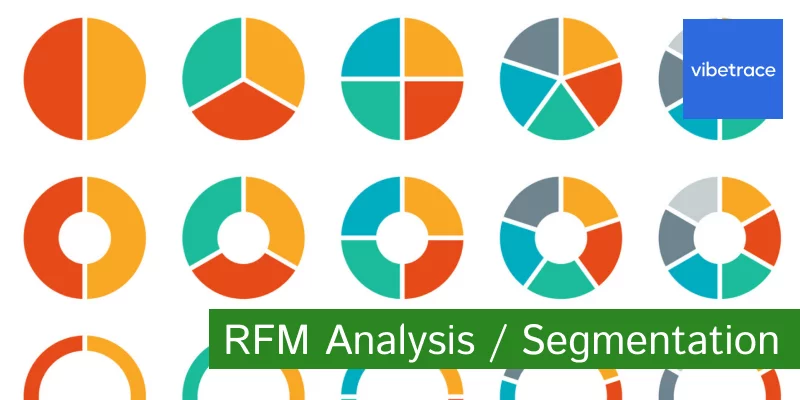Introduction
Are you seeking ways to increase response rates, boost customer retention, and enhance customer lifetime value?
RFM Segmentation is a solution that won’t disappoint you!
Rather than grouping your customers based on age, gender, and geography, which may not be particularly helpful, segmenting them by data derived from their purchase history, campaign responses, and spending behavior can help you identify the specific group they should belong to.
RFM Analysis is easy to interpret without the need for sophisticated software. It serves as an objective tool that provides relevant and high-level information about your customers for your e-commerce business.
If you want to know more about RFM Segmentation, you are on the right page!
In this article, we’ll help you understand everything you need to know about RFM segmentation, including campaign ideas you can implement for your business to help you better serve your customers.
What is RFM Segmentation?
RFM stands for Recency, Frequency, and Monetary Value, each of which represents three criteria based on a customer’s traits and history.
RFM analysis is widely recognized as an effective customer segmentation technique that can help any business enhance its marketing efforts by fostering stronger relationships with customers, ultimately leading to customer loyalty.
Recency
(When was the customer’s last transaction with your store?)
Recency assesses customer activity, which typically involves a purchase. However, variations can also include the customer’s last visit to the website or their most recent interaction.
A high recency score indicates that a customer has recently made a purchase from your store. This score can be determined by examining the time elapsed since the customer’s last purchase, with options like 7 days, 14 days, 1 month, 3 months, and so forth.
In simple terms, recency reveals how responsive a customer is to your brand.
Frequency
(How often does the customer make purchases from your store in a month or a year?)
Frequency indicates how frequently a customer engages with your brand. Customers with more frequent interactions are often more likely to become loyal compared to those who rarely make purchases.
A high-frequency score signifies that a customer makes regular purchases from your store. This score can be calculated by counting the number of purchases made in a given month or year.
For instance, if a customer places five orders within a specific time frame, their frequency score would be 5.
Monetary Value
(How much money has the customer spent on your store?)
Monetary Value reflects the total amount of money spent by a customer within a specific time frame. This information can help you provide exclusive treatment to customers who spend more compared to those who make smaller purchases at your store.
A high monetary value score indicates a significant purchase history with your store. To calculate this, simply sum up the total amount spent by the customer across all their transactions.
Additionally, dividing the monetary value by the frequency provides the average purchase amount, which is another important factor to consider when segmenting your customers.
Do you like this article?
Join our CX for Retail dedicated newsletter!

Stay connected to what’s really important to optimize your digital revenues.
By clicking the button, you accept our Terms & Conditions. Also you will need to confirm your email address.
Why RFM Segmentation Matters
You might be wondering why you should replace your old traditional segmentation with RFM segmentation. Well, there are several compelling reasons that can help your business succeed.
RFM segmentation enables your business to effectively analyze the purchasing behavior of each customer, allowing you to make predictions about their future behavior. In fact, RFM segmentation is more advantageous than traditional segmentation because it is based on historical data between the customer and your business. Moreover, it is easier to analyze, as the gathered data is efficient and accurate, with minimal room for human error.
This makes it simpler for businesses like yours to enhance your marketing efforts and create strategies for customer retention, which directly impacts your customer’s lifetime value. Such segmentation is also easier to implement.
Furthermore, it helps you gain a deeper understanding of your customers and identify the most valuable ones based on their transactions with your business.
Moreover, RFM segmentation can save you time compared to traditional marketing segmentation, which often requires extensive research to make informed decisions.
By utilizing RFM segmentation, your marketing team can efficiently allocate resources for improved marketing, ultimately enhancing your business’s return on investment (ROI).
How to Calculate RFM Metrics
Recency
To calculate Recency, you need to determine the time since the customer’s last purchase.
Example:
Today’s date: September 9, 2023
Customer A’s last purchase date: August 15, 2023
Recency for Customer A = (September 9, 2023 – August 15, 2023) = 25 days
Frequency
To calculate Frequency, count the number of transactions a customer has made.
Example:
Purchase 1: February
Purchase 2: April
Purchase 3: June
Purchase 4: July
Purchase 5: August
Customer B made five purchases in the last year (365 days).
Monetary
Calculate the average spend of all a customer’s transactions to determine their monetary value.
Example:
Customer C made the following purchases in the last year:
Purchase 1: $50
Purchase 2: $75
Purchase 3: $30
Purchase 4: $40
Purchase 5: $100
Monetary for Customer C = $50 + $75 + $30 + $40 + $100 = $295
How to create RFM Segments
Doing RFM Segmentation is getting easier every year. There are many tools in marketing that will allow you to segment customers with ease.
RFM segmentation isn’t really hard. In fact, you can do it yourself.
However, with the aid of software, you can automate it for more accurate results.
Here are the following step-by-step instructions on how to do the RFM segmentation.
Step 1
First, you will need raw data, which can be available from your CRM transactional databases or an Excel spreadsheet. The following raw data includes the recency, frequency, and monetary value of each customer.
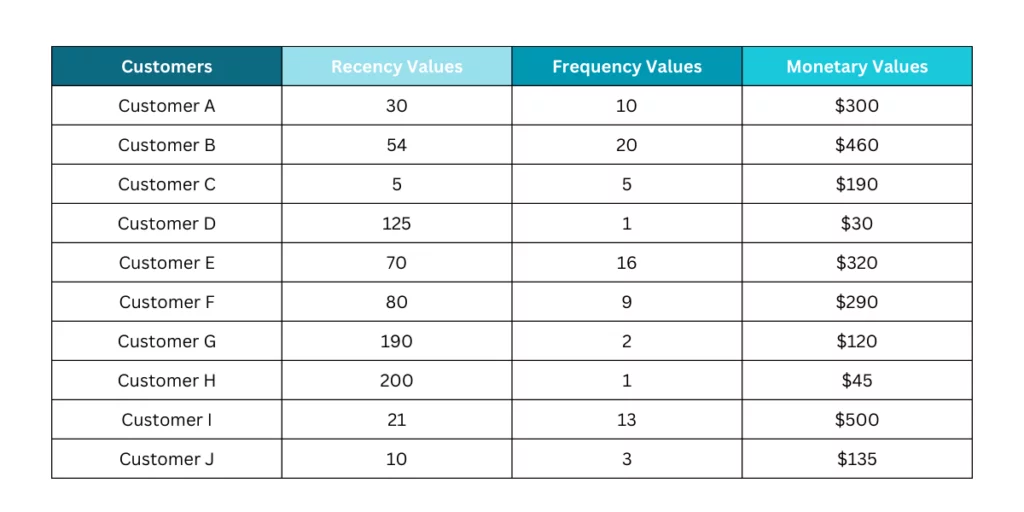
Step 2
Second, the three dimensions R, F, and M must have tiered groups based on the divided customer list using Excel or software. If you choose to use software, you need to assign tiers for each dimension.
For instance, 5 is the most recent, frequent, or highest spend, and 1 is the least or lowest.
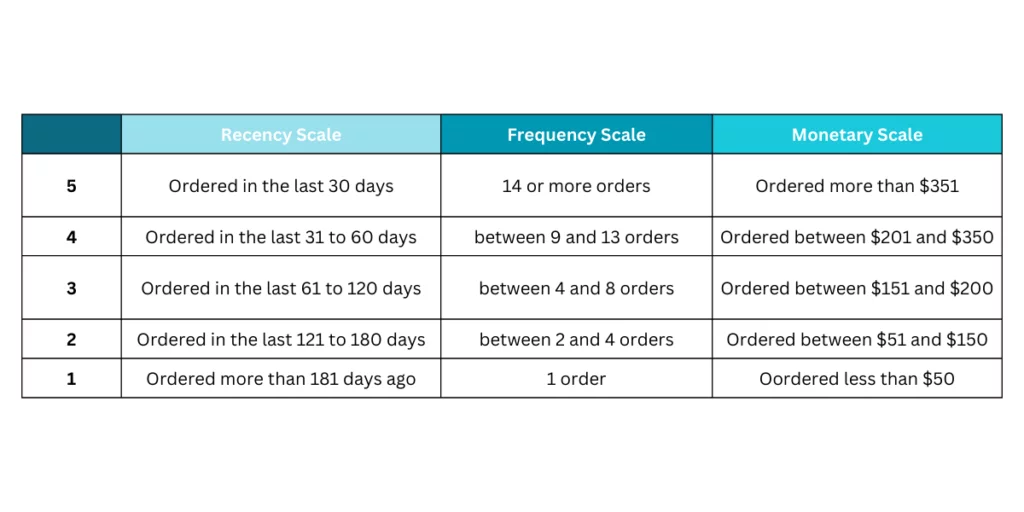
Calculate the total RFM score by adding the scores of your customer’s scores from Recency, Frequency, and Monetary.
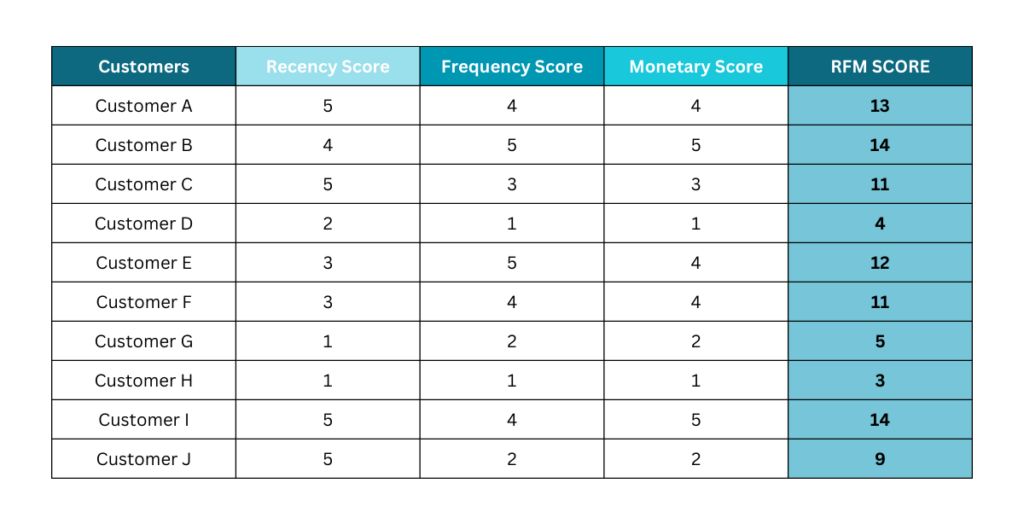
Step 3
Third, based on the RFM segments, you can start selecting a group of customers to whom specific types of communications will be sent.
You can choose to which type of customer your customers belong.
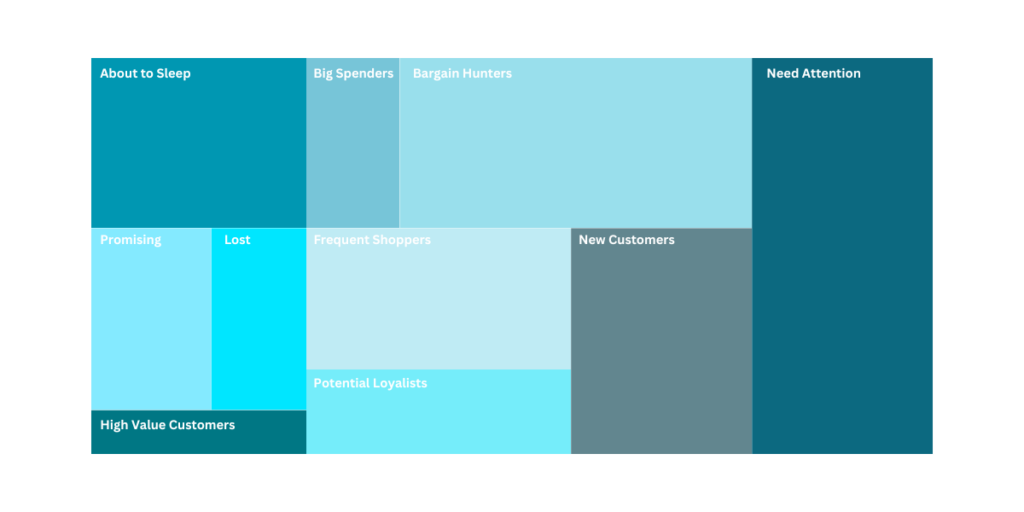
Step 4
Lastly, You can begin crafting a message based on the segmentation that has been created to help you create your campaigns more effectively and communicate with your customers
Types of RFM Segments
Based on the results of your RFM score, you can place your customers in specific types of segments.
Here is a sample table to give you a brief description of each customer segment and actionable recommendations that you can implement to target them:
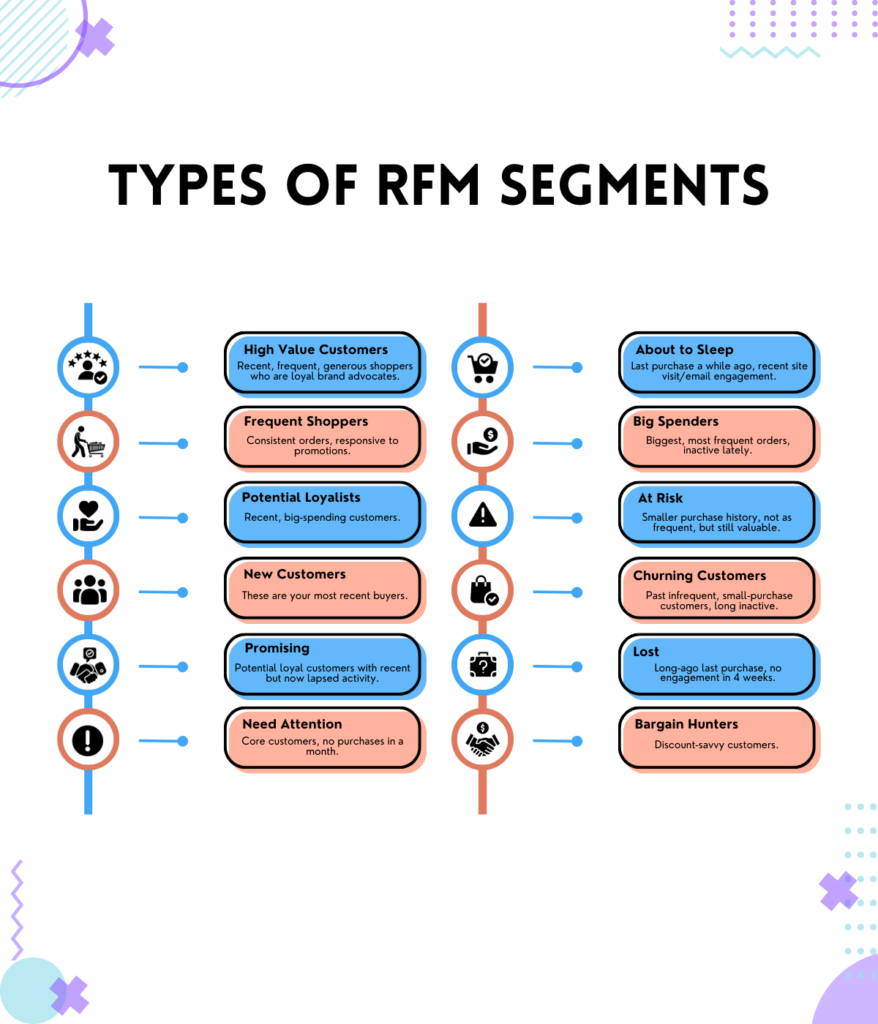
| Segment | Customer Behavior | Recommended Actions |
| High Value Customers | These customers have made recent purchases, order frequently, and spends generously. They are loyal supporters and brand advocates. | Provide onboarding support, grant them early access, and focus on building a strong customer relationship. |
| Frequent Shoppers | These customers consistently place orders and respond well to promotions. | Upsell higher-value products and kindly ask for their reviews to maintain their loyalty. |
| Potential Loyalists | Recent customers who have made substantial purchases. | Encourage their loyalty by offering membership or loyalty programs. Keep them engaged and provide personalized product recommendations. |
| New Customers | These are your most recent buyers. | Provide on-boarding support, grant them early access, and focus on building a strong customer relationship. |
| Promising | These customers showed potential loyalty a few months ago, making frequent and substantial purchases. However, their last purchase was several weeks ago. | Offer them coupons, re-engage them on the platform, and provide personalized product recommendations to regain their interest. |
| Need Attention | Core customers who haven’t made a purchase in over a month. | Create limited-time offers and provide personalized product recommendations to entice them back to your business. |
| About to Sleep | Although they made their last purchase a while ago, they have recently visited your site or engaged with your emails in the past 4 weeks. | Craft highly personalized email subject lines and offer specific discounts on selected products to rekindle their interest. |
| Big Spenders | These customers have made the largest and most frequent orders but have been inactive for a while. | You can provide them with discount coupons or email them during clearance sales. |
| At Risk | Similar to “Cannot Lose Them,” but with smaller purchase and frequency history. | Provide valuable resources on your site and send personalized emails to retain their interest. |
| Churning Customers | Customers who previously made smaller and infrequent purchases but have been inactive for an extended period. | Include them in your standard email communication, but monitor for potential content flagging as spam. Avoid excessive spending on this segment. |
| Lost | These customers made their last purchase a long time ago and have shown no engagement in the last 4 weeks. | Attempt to revive their interest with a targeted outreach campaign, or consider them lost if there is no response. |
| Bargain Hunters | These customers keep an eye out for large discounts and good deals. | You can provide them discount coupons or email them during clearance sales. |
Tailoring Marketing Strategies for Each Segment
Campaign ideas for different RFM segments, from high-value customers to those at risk of churning.
Campaign Ideas for RFM Segments:
High-Value Customers (High R, High F, High M)
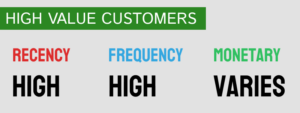
- Exclusive Offers: Give them first dibs on new products or exclusive discounts.
- Loyalty Programs: Invite them to a VIP loyalty program with special perks.
New Customers (High R, Low F, Varies M)
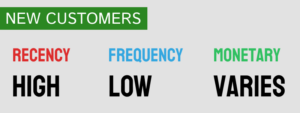
- Welcome Series: A warm welcome and an intro to your brand.
- First-Time Buyer Discounts: Encourage that first purchase.
At-Risk Customers (Low R, High F, High M)
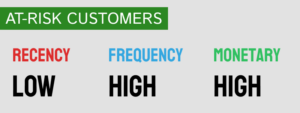
- Win-Back Campaigns: Special offers to lure them back.
- Feedback Surveys: Ask what you can do to improve.
Churning Customers (Low R, Low F, Low M)
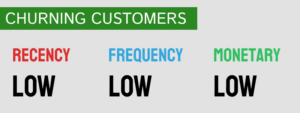
- Re-Engagement Campaigns: Discounts or gifts to reactivate interest.
- Goodbye Email: A last-ditch effort with an opt-out option and a “We’ll miss you” message.
Frequent Shoppers (Varies R, High F, Varies M)
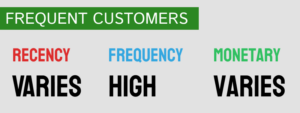
- Flash Sales Alerts: They shop often, so they’ll appreciate the heads-up.
- New Arrivals: Keep them in the loop on the latest products.
Big Spenders (Varies R, Varies F, High M)
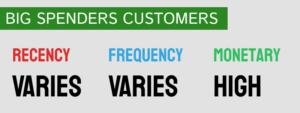
- Personalized Recommendations: Suggest high-value items they might like.
- Exclusive Events: Invite them to special events or webinars.
Bargain Hunters (Varies R, High F, Low M)
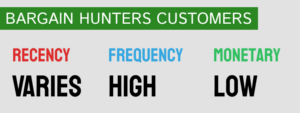
- Clearance Sales: They love a good deal, so keep them posted.
- Coupon Campaigns: Send them special discount codes.
Common Mistakes to Avoid
RFM (Recency, Frequency, Monetary) segmentation is a powerful technique for categorizing and analyzing customer behavior.
However, there are several common mistakes and pitfalls that businesses should avoid when implementing RFM segmentation. Here are some of the most important ones:
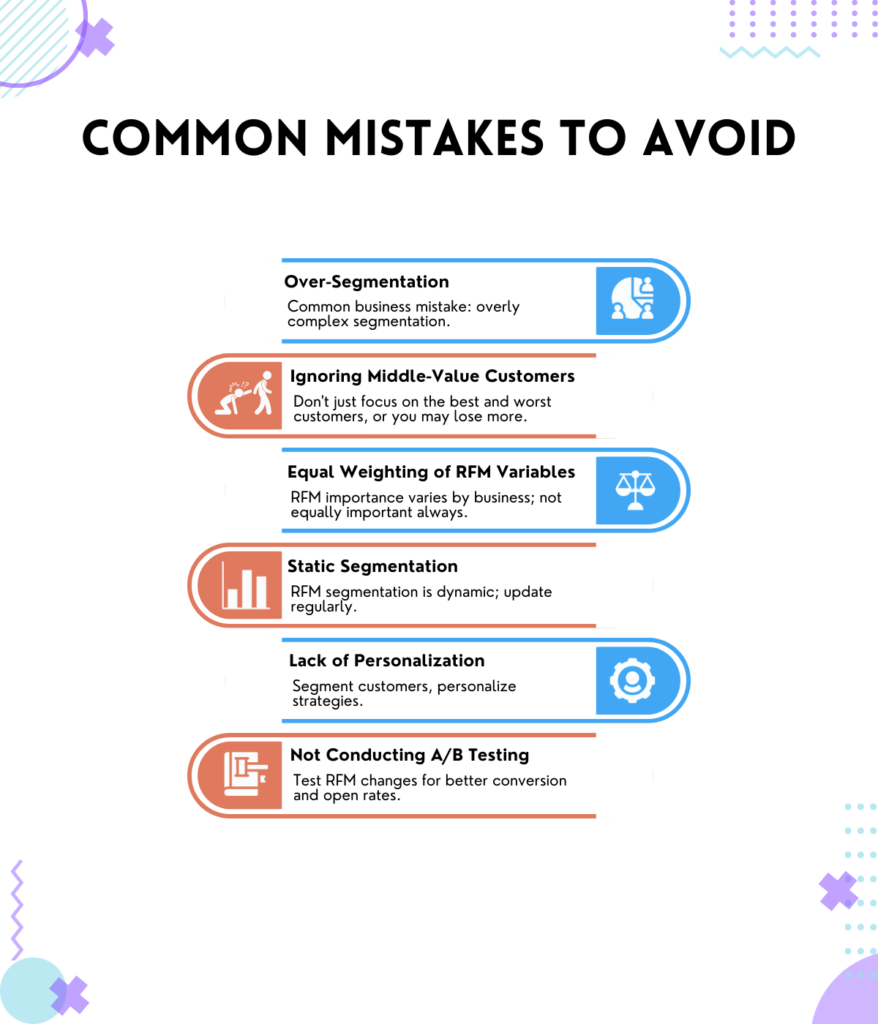
Over-Segmentation
One of the most common mistakes that businesses make is creating too many segments. While having highly granular segments may seem appealing, it can lead to complexity and make it difficult to take actionable steps based on the segmentation.
It’s always better to aim for a balance between granularity and practicality.
Ignoring Middle-Value Customers
It’s a mistake to focus only on your best and worst customers, as this may lead to losing more customers.
Middle-value customers can represent a significant portion of your revenue, and neglecting them may lead to missed opportunities. Customers who often make big purchases may purchase once in a long period of time, but your middle-value customers can give you a stable cash flow.
Consider them in your segmentation and marketing strategies, and don’t leave any segmentation behind as all are important.
Equal Weighting of RFM Variables
Treating Recency, Frequency, and Monetary value as equally important can be misleading at times. Different businesses may place different weights on these factors based on their specific goals and industries.
So, keep in mind your goals and targets so you can weigh RFM variables according to the needs of your business and make sure that you are not wasting time on irrelevant marketing strategies.
Ensure that the weights are adjusted to reflect your business priorities accurately.
Static Segmentation
RFM segmentation should not be static and will never be static.
Customer behavior changes over time, so it’s important to regularly update your segments and adapt your strategies accordingly. A one-time segmentation may quickly become outdated.
Your frequent shoppers can be big-time buyers in the future or bargain hunters can be at-risk customers that you have to win back.
Lack of Personalization
After segmenting customers, it’s important to personalize your marketing and communication strategies for each segment.
Make use of their names to add value to our emails and to make them feel exclusivity.
Failing to do so can result in generic messaging that doesn’t resonate with the unique needs and preferences of each group.
Not Conducting A/B Testing
Implementing changes based on your RFM segmentation without testing their effectiveness is a mistake. This can end up giving you low conversion rates and open rates.
A/B testing allows you to validate whether your strategies are actually improving customer engagement and revenue.
Measuring the Success of RFM Segmentation
Customer Retention
Track the retention rates of different RFM segments over time.
If certain segments show declining retention, focus on improving your strategies for those segments, such as personalized offers or targeted communication.
Average Order Value (AOV)
Analyze how AOV varies across different RFM segments.
Adjustment: If certain segments have low AOV, experiment with upselling and cross-selling strategies tailored to their preferences to increase AOV.
Conversion Rate
Measure the conversion rates for different RFM segments.
If conversion rates are low for specific segments, work on optimizing the user experience and messaging for those segments to improve conversion.
Customer Lifetime Value (CLV)
Calculate the CLV for each RFM segment.
If CLV is low for certain segments, focus on strategies to increase customer loyalty and repeat purchases, such as loyalty programs or targeted rewards.
Marketing ROI:
Evaluate the return on investment (ROI) for marketing campaigns targeting specific RFM segments.
If the ROI is not satisfactory for certain segments, consider reallocating your marketing budget to more profitable segments or adjusting the messaging and channels for those segments.
Conclusion
Properly segmenting your customers based on their purchasing behaviors can help you personalize your emails based on their responses and what they need from your store.
For instance, you can send emails regarding discounts to bargain hunters, while you can recommend higher-value products to frequent shoppers.
Simply put, this can help you increase your conversion rate and maximize your return on investment.
Furthermore, it’s best to understand that the traditional ways of segmenting customers are no longer as effective as you think.
This is why implementing RFM segmentation is the best way to identify your customer group, which can help your sales and marketing teams.
How? By sending relevant marketing to every customer and incorporate better strategies and techniques that will benefit your business.

